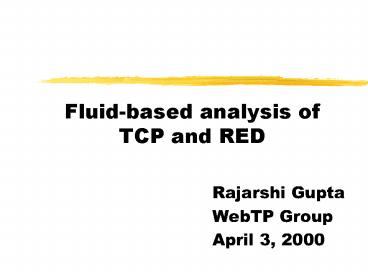Fluid-based analysis of TCP and RED - PowerPoint PPT Presentation
1 / 24
Title:
Fluid-based analysis of TCP and RED
Description:
Recall 'Stochastic Differential Equation Modeling and Analysis of ... ftp://gaia.cs.umass.edu/pub/Misra99-TCP-Stochastic.ps.gz. Presented by RG _at_ WebTP 11/08/99 ... – PowerPoint PPT presentation
Number of Views:26
Avg rating:3.0/5.0
Title: Fluid-based analysis of TCP and RED
1
Fluid-based analysis ofTCP and RED
- Rajarshi Gupta
- WebTP Group
- April 3, 2000
2
Paper being Presented
- Fluid-based Analysis of a Network of AQM Routers
Supporting TCP Flows with an Application to RED - AQM Active Queue Management
- Authors
- Vishal Misra
- Don Towsley
- et al. (?)
- Work in progress, early Preprint
3
Previous Work
- Recall Stochastic Differential Equation Modeling
and Analysis of TCP-Windowsize Behavior, Vishal
Misra, Wei-Bo Gong, Don Towsley - Presented at Performance99, Istanbul,
Turkey, October99 - ftp//gaia.cs.umass.edu/pub/Misra99-TCP-Stochastic
.ps.gz - Presented by RG _at_ WebTP 11/08/99
4
Key Ideas of Old Paper
- Consider network as source of losses and sources
as recipient of these signals - Model loss arrival as independent Poisson process
- Use Stochastic Differential Equations Queuing
Theory to estimate Rate - Compare with existing data and analytical model
(Padhye - SIGCOMM98)
5
Themes of Current Paper
- Use SDE to model COMPLETE system
- TCP characteristic
- Action of AQM routers (RED)
- Evaluate solution of system of equations
- Corollary RED is bad !
- Suggested improvements to RED filtering mechanisms
6
Assumptions
- Model of complete system
- Pkt losses no longer independent parameter
- TCP window size depends on RTT and RED pkt
discard function - Pkt loss is function of Q estimate and Q lengths
- Q length is a function of window sizes
- Pkt losses to flow i are described by Poisson
process Ni (t) with rate ?i (t) - RTT Ri (t) Ai (t) q(t)/C
7
TCP Window Size
- Window size defined by
- Taking expectations
- Here Ex ?x
- Approximation used was Ef(x) ? f(Ex)
- Hence,
1
8
Pkt Loss Function
- RED discards
- Let x be exponentially weighted MA sampled every
? seconds
- Converting to DE and sampling
- Comparing coefficients and taking expectations
2
9
Behavior of q
- Differential version of Lindleys equation
- -1q(t)C is pkt servicing
- Wi / Ri (q) is arrival of pkts from TCP flow i
- Then,
- For a bottlencked Q, q(t)gt0 w.p. 1
- Hence,
3
10
Building Entire System
- N2 coupled equations
- N2 unknowns (?x,?q,?Wi )
- Solve numerically
- These values can yield
- R
- ?
- etc
- We have,
1
2
3
11
Extensions to a Network
- Generalize
- variables to vectors
- vectors to matrices
- Subscript v denotes a specific router
- Then,
- Replacing the old system of equations
- is same (for V routers)
1
2
3
So we get a total of N2V unknowns to solve
numerically
12
Further Complications
- Timeout losses
- Slow-Start
- Aggregation of identical flows
- Same route and same RTT
- Different variations of TCP
13
Application RED
- Compare the system with a network with RED as the
AQM policy in routers - Network simulated using ns
- Differential equation solver done in Matlab
- RED updates estimate every arrival
- Here, choose ?v 1/Cv where Cv is the link
capacity in pkts/sec
14
Topology
- Two RED routers
- S2 goes through both
- S1, S3 use only Q1
- S4, S5 use only Q2
- Symmetric case (both Q capacities 5 MB/s)
- Asymmetric case (Q1 5 MB/s, Q2 2.5 MB/s)
15
DiffEq Model works well (1/4)
16
DiffEq Model works well (2/4)
17
DiffEq Model works well (3/4)
18
DiffEq Model works well (4/4)
19
Effect of Packet Size (1/2)
20
Effect of Packet Size (2/2)
21
Effect of value of ?
22
Flaws in RED
- If a busy state is followed by long silence, RED
does not notice the silence - When there are rapid arrivals, average queue size
closely follows instantaneous value - Discontinuity in drop function also bad and
should be eradicated
23
Suggestions for RED
- Adaptive nature of sampling interval is harmful
and leads to oscillations - Oscillations caused by many factors like pkt
size, link bw, load level etc - Need to incorporate an appropriate sampling
interval ? in the sampling mechanism - Trying to design a better filter with nicer
capabilities (Claims to be nearly there -)
24
Contributions
- An improved methodology of TCP modelling
- Analytical
- Computationally efficient
- Models the complete system
- Matches well with simulation
- Demonstrates inefficiencies of RED under certain
circumstances - Working on improved averaging mechanism





























